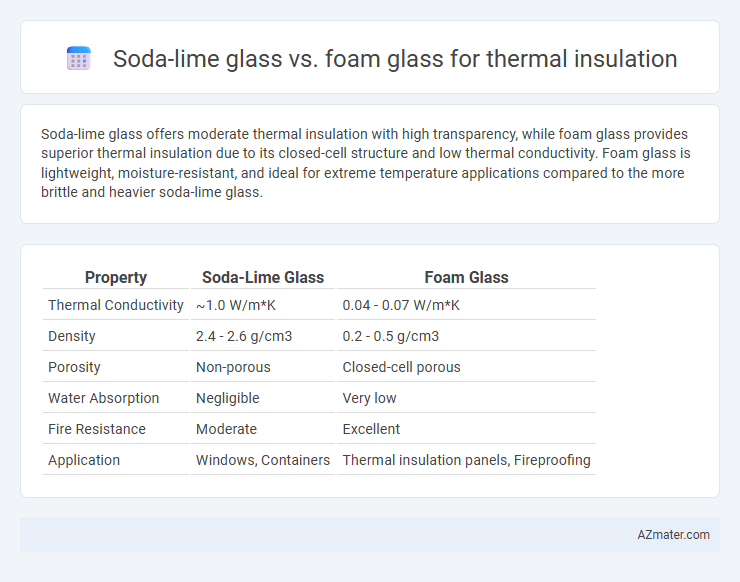Soda-lime glass offers moderate thermal insulation with high transparency, while foam glass provides superior thermal insulation due to its closed-cell structure and low thermal conductivity. Foam glass is lightweight, moisture-resistant, and ideal for extreme temperature applications compared to the more brittle and heavier soda-lime glass.
Table of Comparison
| Property | Soda-Lime Glass | Foam Glass |
|---|---|---|
| Thermal Conductivity | ~1.0 W/m*K | 0.04 - 0.07 W/m*K |
| Density | 2.4 - 2.6 g/cm3 | 0.2 - 0.5 g/cm3 |
| Porosity | Non-porous | Closed-cell porous |
| Water Absorption | Negligible | Very low |
| Fire Resistance | Moderate | Excellent |
| Application | Windows, Containers | Thermal insulation panels, Fireproofing |
Introduction to Thermal Insulation Materials
Soda-lime glass is widely used in thermal insulation due to its affordability and ease of manufacturing, but it offers limited thermal resistance compared to foam glass. Foam glass, composed of crushed glass with a closed-cell structure, provides superior insulation by reducing heat transfer and offering enhanced moisture resistance. Foam glass's lightweight and low thermal conductivity make it a more effective material for thermal insulation in energy-efficient buildings.
Overview of Soda-Lime Glass
Soda-lime glass is the most commonly produced glass, composed primarily of silica (SiO2), soda (Na2O), and lime (CaO), offering good thermal stability and moderate insulating properties. It is widely used in window panes and containers but has limited thermal insulation performance compared to foam glass due to its higher density and lower porosity. Foam glass, by contrast, contains air-filled pores that significantly enhance thermal insulation, making it preferable for applications requiring superior heat resistance and energy efficiency.
Overview of Foam Glass
Foam glass is a highly effective thermal insulation material made from recycled glass that is crushed, mixed with a foaming agent, and then heated to create a lightweight, porous structure with excellent insulating properties. Unlike soda-lime glass, which is a common flat glass primarily used for windows and containers, foam glass offers superior compressive strength, moisture resistance, and fireproof characteristics, making it ideal for industrial and construction applications. Its closed-cell structure provides low thermal conductivity and durability, ensuring long-term energy efficiency in buildings and infrastructure.
Thermal Conductivity: Soda-Lime vs Foam Glass
Foam glass exhibits significantly lower thermal conductivity, typically around 0.04 W/m*K, compared to soda-lime glass, which has a thermal conductivity of approximately 1.0 W/m*K, making foam glass far more effective for thermal insulation applications. The cellular structure of foam glass traps air within its closed pores, drastically reducing heat transfer, whereas soda-lime glass's dense, non-porous composition allows greater heat conduction. Selecting foam glass over soda-lime glass results in superior energy efficiency in building and industrial insulation systems due to its enhanced thermal resistance.
Mechanical Strength and Durability Comparison
Soda-lime glass exhibits moderate mechanical strength with notable brittleness under impact, while foam glass offers superior durability due to its cellular structure that enhances resistance to compression and thermal shock. Foam glass's closed-cell formation provides higher compressive strength, typically ranging from 1 to 5 MPa, outperforming soda-lime glass that lacks such porosity and suffers from lower impact resistance. The enhanced durability of foam glass makes it more suitable for thermal insulation applications where mechanical stress and long-term stability are critical.
Moisture Resistance and Chemical Stability
Foam glass exhibits superior moisture resistance compared to soda-lime glass due to its closed-cell structure, preventing water absorption and ensuring long-term thermal insulation performance. Chemically, foam glass remains stable in aggressive environments, resisting acids and alkalis, whereas soda-lime glass can degrade when exposed to moisture and alkali compounds, reducing its durability. These properties make foam glass a preferred choice for thermal insulation applications requiring high chemical stability and moisture resistance.
Environmental Impact and Sustainability
Soda-lime glass, commonly used in windows and containers, has a lower environmental impact during production due to abundant raw materials and established recycling systems but offers moderate thermal insulation properties. Foam glass, made from recycled glass and characterized by its cellular structure, provides superior thermal insulation and is highly sustainable due to its use of post-consumer glass and long lifespan reducing energy consumption. Comparing both, foam glass stands out as the more eco-friendly option for thermal insulation, significantly decreasing carbon footprints through enhanced energy efficiency and waste reduction.
Installation and Practical Applications
Soda-lime glass offers ease of installation with its lightweight sheets and compatibility with conventional glazing hardware, making it ideal for window insulation and decorative facades. Foam glass provides superior thermal insulation with high compressive strength and moisture resistance, suitable for harsh industrial environments and underground piping insulation. Foam glass's rigid structure simplifies installation in complex shapes, whereas soda-lime glass is preferred for applications requiring transparency and aesthetic appeal.
Cost Analysis: Soda-Lime Glass vs Foam Glass
Soda-lime glass is generally more cost-effective for thermal insulation due to its widespread availability and lower manufacturing expenses, making it suitable for large-scale applications. Foam glass, despite higher production costs, offers superior insulation performance and durability, which can lead to long-term savings in energy costs and maintenance. The choice between soda-lime glass and foam glass for insulation ultimately depends on balancing initial investment with lifecycle efficiency and application-specific thermal requirements.
Conclusion: Choosing the Right Insulation Material
Soda-lime glass offers cost-effective thermal insulation with moderate insulating properties suitable for non-extreme temperature applications, while foam glass provides superior insulation performance, excellent moisture resistance, and enhanced durability ideal for harsh environments. Selecting the right material depends on specific project needs, balancing factors such as thermal conductivity, compressive strength, and exposure conditions. Foam glass is optimal for high-performance insulation in demanding settings, whereas soda-lime glass meets basic insulation requirements with budget considerations.

Infographic: Soda-lime glass vs Foam glass for Thermal insulation
 azmater.com
azmater.com